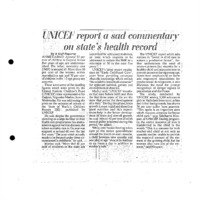UNlCEF report a sad commentary on state’s health record
Item
- Title
-
UNlCEF report a sad commentary
on state’s health record - extracted text
-
RF-CH-6.6 SUDHA
VNlCEF report a sad commentary
■■ £' on state’s health record
By A Staff Reporter
supervised by untrained midwives,
AHMEDABAD: Around 53 per an issue which requires to be
cent of children in Gujarat, below addressed to reduce the'IMR to a
five years of age. are undernour ■minimum of 50 in the next five
ished. The infant mortality rate -years."; i '■
. ‘
(IMR) is around 60. More than 60
UNICEF's latest report empha
per cent -of the women within sises on “Early Childhood Care”,
reproductive age and 70 per cent apart 'from providing necessary
of children in the 1-2 age group are ' obstetric knowledge which utilises
anaemia
' '
“the available household resources”
-These were some of the startling for optimum survival, growth and
figures which were given by the . development of children.
United Nations Children’s Fund
• Mathur said, “UNICEF visualis
(UNICEF) state representative for es that time before birth and then
Gujarat, Yogendra Mathur, here on
the first three years of life are the
Wednesday. He was addressing the most vital period for development
press on the occasion of release of of a child.” During this phase, brain
the. ‘State of World’s Children growth is most rapid and therefore
Report 2001’, published by good nutrition and rich experi
unicef.
i ences ’help in the better develop
' He said despite the government ment of brain an<) overall growth,
spending on a large number of child ", . he said. “About 40 per cent of adult
health care programmes like immu mental ability is formed during this
'
I . :
nisation againstvarious diseases, the period,”he added.
While only breast-feeding takes
infant mortality rate in Gujarat was
stagnant at around 60 over the last care pV the entire nourishment
five years. “The area which actually around the fourth to sixth months,
needs to be focused under th’ese cir a child between nine months and
, one year of age “should be fed four
cumstances is childbirth,” he said.
■ Mathur said, “More that 40 per to six times a day in addition.to
'. '■'h'j-j-j'y '.i
cent of Chidbirth in'tfie state are mother’s milk”. ’ ;
The UNICEF report which asks
nations to “invest in child care to
ensure a productive future”, fur
ther underscores. the need of
micro-nutrients like vitamins for a
healthy child and adequate iron to
prevent anaemia during young age.
Apart from emphasising on warm
and responsive interactions for
psycho-social development, it also
discusses the need for prompt
recognition of danger signals of
pneumonia and diarrhoea.
The study, conducted by
UNICEF among 3,000 adolescent
girls in Vadodara from rural, urban
and tribal backgrounds, has shown
76 per cent suffer from anaemia.
“This again is an important area
which requires attention for better
child care,” says Siddharth Niru- ■
pam of UNICEF. During pregnan
cy, the entire resource of iron is
transferred to the child' in the
womb. “This is a concern for both
mother and child as not only an
anaemic mother unable to provide
the required amount of the ele- ;
ment to the growing child, but the .
woman also runs out of the ele
ment,” said Nirupam. ' . Yj ' '• '
- Media
 RF-CH-6.6 SUDHA.pdf
RF-CH-6.6 SUDHA.pdf
Position: 6174 (1 views)
